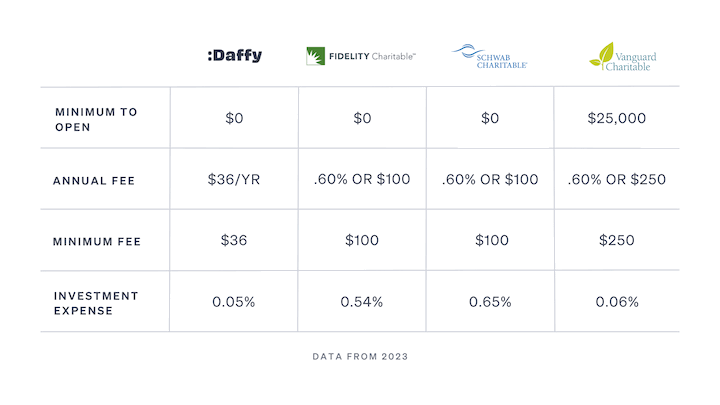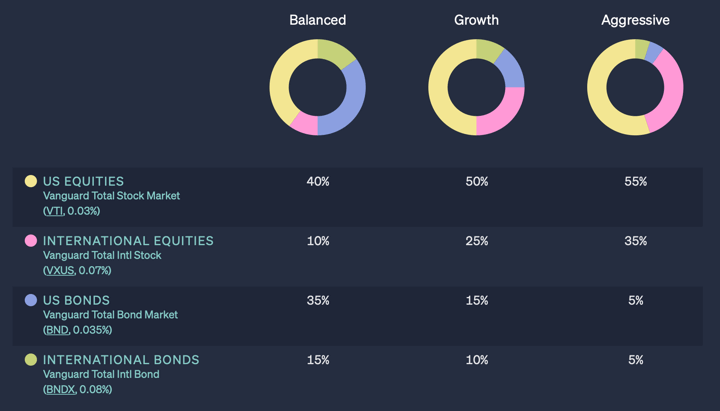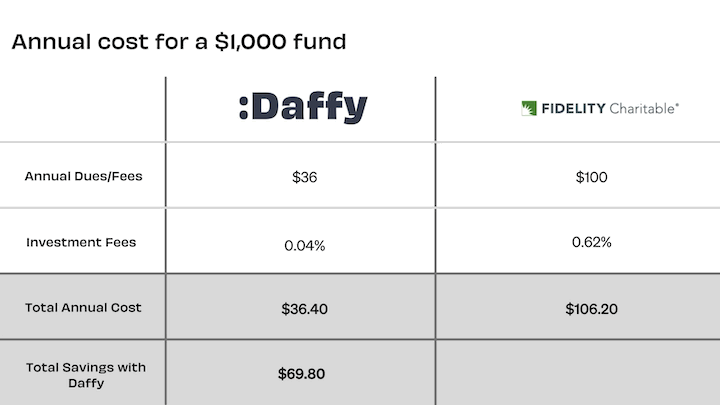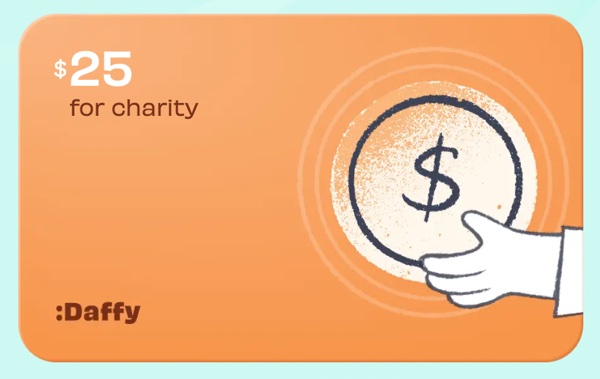
Updated review 2023. A donor-advised fund (DAF) helps you manage the timing of your charitable giving while also maximizing your tax benefits (allowing you to give more). You get the tax break at the time of contribution, which means you can give more when your income and tax rates are higher.
Donating appreciated stock or mutual fund shares (or crypto) is one of the most efficient ways to donate. You avoid both paying taxes on capital gains and get a tax deduction for the full current market value if you itemize. Here is an examples of the double tax advantage of donating appreciated stock. Your contributions can then be invested to grow a tax-deferred manner until you decide to make a grant to the charities of your choice.
One problem for small investors is that the “Big 3” of DAFs: Fidelity, Vanguard, and Schwab all charge annual administrative fees of 0.60% of assets with a minimum fee of $100 to $250. (Update: As of 2024, Schwab no longer has a minimum asset-based fee.) In addition, you are usually stuck with a limited menu of investment options, many of which may have expense ratios that are higher than common index ETFs. Vanguard has cheaper options, but they have a $25,000 minimum opening amount. Both the account management fees and portfolio investment fees are funds skimmed away from the charities themselves.
Daffy is a newer DAF startup that charges only $3 a month, or a flat $36 a year regardless of asset size. Importantly, this tier now also allows the donation up to $25,000 in appreciated stock (lifetime cumulative). Their 13 preset portfolios include ones with four low-cost and broad Vanguard ETFs (VTI, VXUS, BND, and BNDX) with a rock-bottom overall expense ratio of as low as 0.05%.

If you are an individual investor that also wants to donate a modest amount of appreciated stock from any brokerage, the end result is that with Daffy, a larger percentage of your donation will end up going to charity.

Personally, I’ve had a Fidelity Charitable DAF for a few years now, and it has been a smooth experience even though I am a small fry customer. I am able to donate appreciated assets from my Fidelity brokerage accounts with ease, and then give most of it away. I don’t maintain an exceptionally large balance (so I worry less about the portfolio fees), and my fees are the $100 a year minimum.
Other competitors include CharityVest, which has a higher $4/month minimum (0.40% asset-based) but also no limit on the amount of appreciated securities that you can donate. The 0.40% asset-based fee does mean that starting at a $12,000 balance, you are going to exceed the $4/month minimum. They do offer a low-cost ETF portfolios.
$25 referral bonus (for charity). I have just opened a Daffy account to try them out. I was able to contribute up to $1,000 initially via credit card with no processing fees. I discovered that if you open via a my Daffy referral link, you will get an extra $25 in your DAF after funding. If four people open with my link, I will get $100 added to my charitable fund. (All proceeds on both sides go into the DAF, and thus will eventually go to a charitable non-profit.)
Bottom line. If you plan on donating modest amounts of appreciated assets under their $25,000 lifetime limit, then Daffy is the lowest-cost DAF that I am aware of that lets you manage the timing of your charitable contributions and invest it tax-free until you decide to make a grant. (Update: As of 2024, Schwab no longer has an asset minimum. Thus, if you hold less than $6,000 in the Schwab DAF at 0.60% fee, then your annual account fee will be lower than Daffy’s flat $36 a year.)

 The Best Credit Card Bonus Offers – 2025
The Best Credit Card Bonus Offers – 2025 Big List of Free Stocks from Brokerage Apps
Big List of Free Stocks from Brokerage Apps Best Interest Rates on Cash - 2025
Best Interest Rates on Cash - 2025 Free Credit Scores x 3 + Free Credit Monitoring
Free Credit Scores x 3 + Free Credit Monitoring Best No Fee 0% APR Balance Transfer Offers
Best No Fee 0% APR Balance Transfer Offers Little-Known Cellular Data Plans That Can Save Big Money
Little-Known Cellular Data Plans That Can Save Big Money How To Haggle Your Cable or Direct TV Bill
How To Haggle Your Cable or Direct TV Bill Big List of Free Consumer Data Reports (Credit, Rent, Work)
Big List of Free Consumer Data Reports (Credit, Rent, Work)
There’s another “catch” and it’s a big one, in my opinion. Each of the 9 portfolios keeps 10% of your money in cash. The opportunity cost of that, conservatively assuming 6% returns, is 0.6%.
Earn a better return, and Daffy’s hidden fee exceeds the fees charged by the big players. The crypto portfolios are an interesting feature that the others don’t have, though.
I’m keeping a keen eye on Charityvest (https://www.physicianonfire.com/charityvest <- waitlist referral). Their highest fee tier is 0.45% and it goes down as your balance increases.
Cheers!
-PoF
About Physician On FIRE’s comment, Daffy no longer has that 10% in cash in their portfolios. They say they never used that for profit, it was just done as a sensible allocation to have funds available for use that aren’t invested. But in any case, they removed that cash allocation.
I am concerned about these donations going to a cause that I don’t support. I only donate to organizations that share my conservative religious views, do I have control of that here?
You can choose to direct your grant to any IRS-qualified 501c3 non-profit. Although you lose ownership of the assets forever, you are the donor and they follow your “advice” to where to send the grants.
https://en.wikipedia.org/wiki/Donor-advised_fund
Thank you, Jonathan, for your insightful article. I’ve heard of donor advised funds before and had considered opening a Schwab Charitable Fund account only because I’m already a Schwab brokerage client. Prompted by your article to learn more, I researched donor advised funds more thoroughly than ever before.
I came across this article “A Comparison of Donor-Advised Fund Providers” by Michael Dickens.
https://mdickens.me/2021/04/05/comparison_of_DAF_providers/
Although he didn’t mention DAFFY, he did talk about CharityVest, which you also mentioned. Since both DAFFY and CharityVest are relatively new to the list of DAF providers, I was especially intrigued by Michael’s comment about CharityVest:
Purely in terms of features, Charityvest looks like the best provider—it has the lowest fees and offers a wide range of investment options. But I would hesitate to use it because it’s new—it only launched in 2021 and didn’t allow investments until 2022. This introduces significant risks. For instance, if Charityvest can’t earn enough money to sustain itself, it might have to dissolve donors’ accounts and use their money to pay its bills (which it has a legal right to do, and donors would have no recourse). So in spite of the upsides, I would not use Charityvest unless I became more confident in its financial stability.
Do you think his concern is legitimate, especially as regarding DAFFY?
Also, I’m currently investing $2000/month in 2 different Schwab ETFs because they are tax-efficient funds. In researching DAFs, I wondered if I should be investing the money in a DAF instead. But then I wondered how an investor is able to reap the benefits of the tax deduction. If I understand correctly, to do so, one would have to itemize deductions and have itemized deductions that are more than the standard deduction. As a single investor, my DAF contributions would have to be more than $13,850 which is the 2023 standard deduction amount. And, if I am reasoning correctly, the amount of savings would be based on how much my contributions were above $13,850. I’d appreciate your confirmation of my logic in this matter, if at all possible. Thanks!
I think that “best” is just hard to define. If you are a small investor that is looking for a low-cost DAF to serve as a “pass-through” that makes it easy to donated appreciated stock (most small charities can’t handle this on their own), and only donate maybe a few thousand per year, the I think Daffy would work fine. Even if they shut down, your DAF can be emptied pretty quickly. I agree that I wouldn’t donate a million dollars to Daffy or CharityVest.
I also agree that having your DAF where your big taxable holding are already is probably the easiest. I’m quite satisfied with my Fidelity account as I’ve already gone through the stock donation process and it was seamless. Everything just works.
On the standard deduction, yes there is that hurdle before you can itemize, but you may have a lot other itemizable deductions already (like state and local taxes, mortgage interest, medical expenses), or you may have zero. Just depends on your situation. You may also choose to stack up multiple years of donations into a single year and “store” it in your DAF.
Thank you, Jonathan, for taking the time to respond to my post. Your answer brought up another question in my mind. Since you currently have a Fidelity Charitable Trust as well as a Daffy account, it’s apparent that you find an advantage in having more than just one donor advised fund. Do you have any more than those two? If so, which ones? What do you see as an advantage of using more than one DAF?
In thinking over the advantages of a DAF, I came to realize that, even though the tax deduction requires that I itemize deductions rather than taking the standard deduction, using a DAF would allow me to stash away money that will not earn any interest, dividends, or capital gains that would require me to pay more in taxes, so I’d eventually have more money available to donate to charitable organizations in the future. Would you agree?
I’m actually pretty happy with my Fidelity DAF, I don’t plan on closing it right now even though it cost $100 a year. I’m just trying out Daffy out of curiosity, really, but might shut it down later.
I think of the DAF as a little mini-foundation with much lower costs and lots of flexibility. I researched real foundations but they were too much trouble. With a DAF, I contribute money whenever I want and I can distribute whenever I want. If I don’t, the money is invested and grows.
DAFFY CONSERNS
Daffy does not do 2 step authentication! Any financial firm has LONG AGO figured out that a user and password is not security enough to keep your money safe. I can’t think of a financial firm that holds your money that at least has this option.
Another security risk is the API. Allowing other software, write by you or a third party or hacker having access to your account I have never seen at a financial firm. If the API key generation is hacked or discovered, (inside job) hold onto your hat for a one minute job to empty all the accounts.
I believe Schwab no longer charges a minimum of $100/yr. It is now a flat 0.6%/yr.
Thanks for the heads up, looks like they changed it sometime in early 2023? I will update the post.
The new flat rate fees (0.6%/yr) appear to be so from using the Schwab Charitable website calculator but I have not called them to verify.
IMO, a flat rate of 0.6%/yr makes Schwab the most compelling option for small investors. Schwab also offers index investing options, e.g. total stock @ 0.03%.
Agreed, this does change the comparison in favor of Schwab, especially for balances under $6,000.
Does anyone have a CharityVest referral link? I see that they have a program (referral and affiliate link programs), but I can’t find a shared referral link anywhere. Anyone have a CharityVest account themselves and would refer me? Thanks!